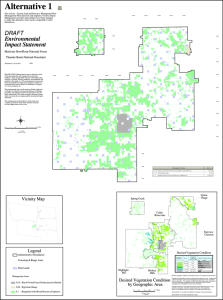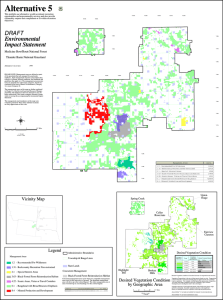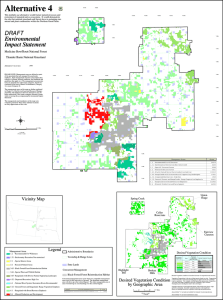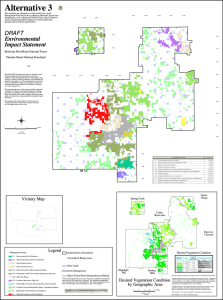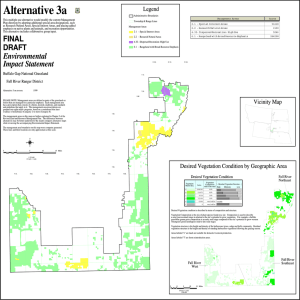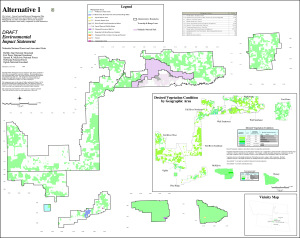Document 11289796
advertisement
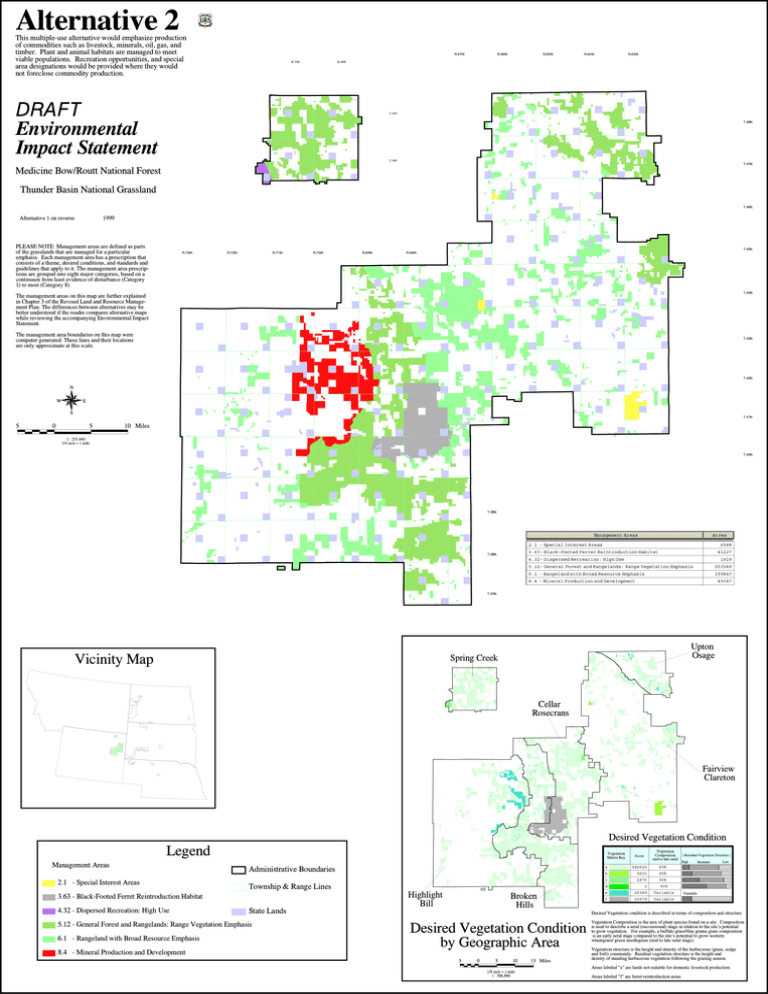
Alternative 2 This multiple-use alternative would emphasize production of commodities such as livestock, minerals, oil, gas, and timber. Plant and animal habitats are managed to meet viable populations. R.67W. Recreation opportunities, and special R.70W. R.66W. R.65W. R.64W. R.63W. R.69W. area designations would be provided where they would not foreclose commodity production. DRAFT T.55N. T.48N. Environmental Impact Statement T.54N. T.47N. Medicine Bow/Routt National Forest Thunder Basin National Grassland T.46N. Alternative 1 on reverse 1999 PLEASE NOTE: Management areas are defined as parts T.45N. of the grasslands that are managed for a particular emphasis. R.73W. R.72W. R.71W. R.70W. R.69W. R.68W. Each management area has a prescription that consists of a theme, desired conditions, and standards and guidelines that apply to it. The management area prescriptions are grouped into eight major categories, based on a continuum from least evidence of disturbance (Category 1) to most (Category 8). T.44N. The management areas on this map are further explained in Chapter 3 of the Revised Land and Resource Management Plan. The differences between alternatives may be better understood if the reader compares alternative maps while reviewing the accompanying Environmental Impact Statement. The management area boundaries on this map were T.43N. computer generated. These lines and their locations are only approximate at this scale. T.42N. N W E S T.41N. 5 0 5 10 Miles 1 : 253,440 1/4 inch = 1 mile T.40N. T.39N. Management Areas 2.1 Acres - Special Interest Areas 6588 3.63- Black-Footed Ferret Reintroduction Habitat T.38N. 41227 4.32- Dispersed Recreation: High Use 1929 5.12- General Forest and Rangelands: Range Vegetation Emphasis 253549 6.1 - Rangeland with Broad Resource Emphasis 199847 8.4 - Mineral Production and Development 49347 T.37N. Upton Osage Spring Creek Vicinity Map Cellar Rosecrans Fairview Clareton Desired Vegetation Condition Legend Vegetation Matrix Key . Vegetation Composition Acres Acres |-Residual Vegetation Structure-| mid to late seral .2 High Management Areas 2.1 - Special Interest Areas Administrative Boundaries Township & Range Lines 3.63 - Black-Footed Ferret Reintroduction Habitat 4.32 - Dispersed Recreation: High Use - Rangeland with Broad Resource Emphasis 8.4 - Mineral Production and Development Broken Bill Hills State Lands 5.12 - General Forest and Rangelands: Range Vegetation Emphasis 6.1 Highlight a 482624 80% b 5623 85% c 2870 90% d 0 e 20389 Variable f 40979 Variable Moderate Low 90% Variable Desired Vegetation condition is described in terms of composition and structure. Vegetation Composition is the mix of plant species found on a site. Composition Desired Vegetation Condition is used to describe a seral (successional) stage in relation to the site's potential to grow vegetation. For example, a buffalo grass/blue grama grass composition is an early seral stage compared to the site's potential to grow western by Geographic Area wheatgrass/ green needlegrass (mid to late seral stage). Vegetation structure is the height and density of the herbaceous (grass, sedge and forb) community. Residual vegetation structure is the height and 5 0 5 10 15 Miles density of standing herbaceous vegetation following the grazing season. Areas labeled "e" are lands not suitable for domestic livestock production. 1/8 inch = 1 mile 1 : 506,880 Areas labeled "f" are ferret reintroduction areas.
